iModeler Review: Airfix 1/48 Spitfire Vb
In the development of the Spitfire, there is a recurring theme: that outside of the Mk.I, each major sub-type used was actually a “stopgap” design while the “definitive” design undertook more prolonged development. This applies to the Spitfire V, the Spitfire IX and the Spitfire XIV.
Following the end of the Battle of Britain, Fighter Command predicted that the high-altitude Junkers Ju-86P would become the primary bomber type to be intercepted, and requested that Supermarine develop a high-altitude version of the Spitire. This would appear as the Mk. VI. In the meantime, the first Bf-109Fs had appeared on the Channel Front and it was evident this 109 outperformed both the Spitfire I and II. Supermarine then proposed a “stopgap” fighter utilizing the same Merlin-45 engine as the Spitfire VI, mated to a “beefed up” Mk. I airframe. (This would be the same scheme that would result in both the Spitfire IX and the Spitfire XIV).
The first Spitfire V appeared in December 1940, and initial production of the sub-type involved utilization of modified Mk. I airframes at the Supermarine factory in Southhampton and Mk.II airframes at Castle Bromwich. The first squadrons to equip with the new type received their Spitfire Vs in April 1941. Over the course of the spring and summer of 1941, all of Fighter Command's Spitfire squadrons and many of the Hurricane squadrons would re-equip on the Spitfire V, with the last Mk. Is disappearing from operations in June and the last Mk.IIs by late September 1941.
In addition to the Merlin 45, which provided 1,450 horsepower as opposed to the 980 h.p of the Merlin “C” in the Mk. I and the 1,175 h.p. of the Merlin-XII in the Spitfire II, the Spitfire V also introduced a single-stage two-speed supercharger that increased operational ceiling to 35,000 feet with “best altitude” at 29,000 feet (as opposed to the 20,000 feet of the two earlier types). Additionally, the Spitfire V had metal-framed ailerons which vastly improved high-speed roll.
The Spitfire V first appeared as the Type 331, known as the Spitfire Va. 94 were built with the “A” wing carrying eight .303 Colt-Browning machine guns. This sub-type had a top speed of 375 mph, and could climb to 20,000 feet in 7.1 minutes. The best known of these Spitfires is W3185, which was flown by Douglas Bader as commander of the Tangmere Wing and in which he was lost on August 9, 1941.
The Spitfire Vb was the main production version of the Mark V. Along with the new Merlin 45 series the B wing with one 20mm cannon and a 60-round drum in each wing was fitted as standard. As production progressed changes were incorporated, some of which became standard on all later Spitfires. Initial production used Mk Ib airframes converted to Mk Vb by Supermarine. In early 1941 the round section exhaust stacks were changed to a "fishtail" type, marginally increasing exhaust thrust. Some late production Vb and Vc Spitfires were fitted with six shorter exhaust stacks per side, similar to those of Spitfire IXs and Seafire IIIs. After initial problems with the original Mk I oil coolers, a bigger oil cooler was fitted under the port wing that could be recognized by a deeper housing with a circular entry. Metal framed ailerons were also used. A "blown" cockpit hood, manufactured by Malcolm, was introduced to further increase pilot head-room and visibility. Many mid to late production Vb used the improved windscreen assembly with the integral bullet resistant centre panel and flat side screens. Different propeller types were fitted, according to where the airframe was built: Supermarine and Westland manufactured aircraft used three-bladed de Havilland constant speed units, with narrow metal blades, while Castle Bromwich manufactured aircraft were fitted with a wide blade Rotol constant speed propeller with metal blades, or (on late production Spitfires) "Jablo" (compressed wood) blades. The Rotol spinners were longer and more pointed than the de Havilland leading to a 3.5 in increase in overall length.The Rotol propellers allowed a modest speed increase over 20,000 ft and an increase in the service ceiling. These units were also fitted to Supermarine-built aircraft at the squadron level. A number of aircraft were fitted with "gun heater intensifier" systems on the exhaust stacks. which piped additional heated air into the gun bays and was distinguished by a short tubular intake on the front of the first stack and a narrow pipe led into the engine cowling from the rear exhaust. The Vb series were the first Spitfires able to carry a range of specially designed "slipper" drop tanks.
With the appearance of the Focke Wulf Fw 190 on the Channel Front in August 1941, the Spitfire was for the first time truly outclassed. the Spitfire Vb was outperfomred in clim, speed, roll, and zoom, only outmaneuvering the Fw-190 in turns. The Vb was the first version of the Spitfire to use "clipped" wingtips as an option, reducing the wingspan to 32 ft 2 in, which increased the roll rate and airspeed at lower altitudes. Several different versions of the Merlin 45/50 family were used, including the Merlin 45M which had a smaller "cropped" supercharger impeller and boost increased to +18 lb. This engine produced 1,585 hp, increasing the L.F Vb's maximum rate of climb to 4720 ft/min. this version of the Spitfire Vb could outperform both the Fw-190 and Bf-109 below 8,000 feet.
The Mk Vb(trop) used a large Vokes air filter fitted under the nose, which had a detrimental effect on performance, reducing top speed by 8 mph and climb rate by 600 ft/min. Many VB(trop)s were modified by 103 MU at Aboukir, Egypt by replacing the Vokes filter with locally manufactured "Aboukir" filters, which were lighter and more streamlined. Two designs of these filters can be identified in photos: one had a bulky, squared off filter housing while the other was more streamlined. These aircraft were usually fitted with the wide blade Rotol propeller and clipped wings.
The model uses decals from "Spifire: Aces of the Empire" to depict the Spitfire Vb flown by Squadron Leader J.E. "Johnnie" Johnson during his time in command of 610 Squadron, July-December 1942. On August 19, Johnson shot down an Fw-190 over Dieppe, his only victory in this aircraft.
The Kit:
This new kit by Airfix completely displaces the old Spitfire Vb first introduced in the late 1970s. The kit provides all the bits and pieces to do every variety of Spitfire Vb: deHavilland and Rotol propellers; normal and desert oil coolers; Vokes tropical filter; all three varieties of exhausts; all three varieties of canopy hood and both versions of the windscreen. The kit provides decals for an early Spitfire Vb flown by 309 (Polish) Squadron, and a tropical Vb flown by 268 Squadron at Malta, which features a variation of the "Malta blue" camouflage.
I found that assembling the kit with Tenax or Tamiya Thin Cement did not get things fully attached, and ended up finding success with Plastruct Universal Cement, which leads me to suspect this is another of the new kits that isn't using polystyrene plastic. It doesn't have an odor like some of the alternatives do, but it does resist standard polystyrene cement. I do wish the manufacturers would make public note where they do this so modelers can use the proper adhesives.
Assembly is straightforward and presents no problems. I made seat belts from lead foil from a wine bottle. Airfix's Achilles Heel continues to be their clear parts, which in this case are pretty sub-standard in the area of the windshields. I utilized a Falcon/Squadron canopy for the old Spitfire Vb kit, and had no problem getting a better-looking result.
Camouflage and Marking:
The model was painted freehand with Tamiya Ocean Grey, RAF Dark Green and Sea Grey medium, with the sky band and yellow wing leading edges airbrushed and masked first. The decals went on without problem under a coat of Micro-sol. The "Aces of the Empire" sheet is highly recommended; Victory Models has reprinted it recently and it provides several interesting markings options for Spitfire Vb's.
Overall, I think this is Airfix's best Spitfire yet.
Thanks to iModeler for the review kit.
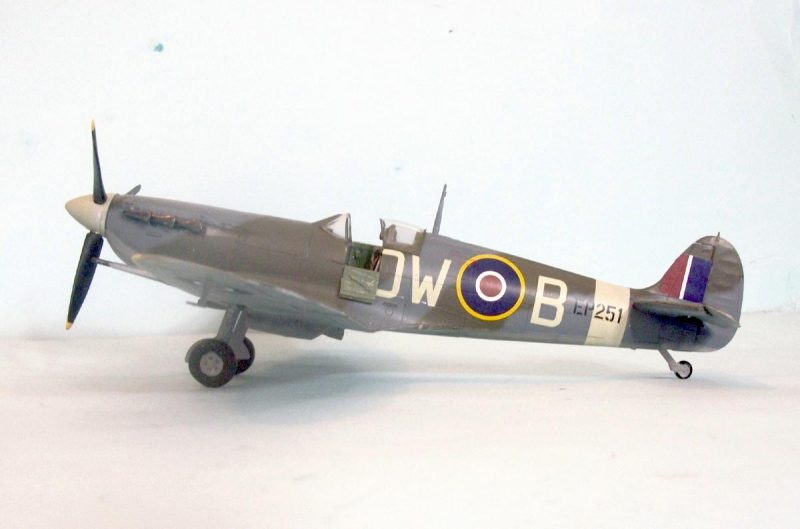
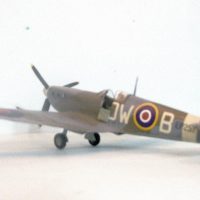
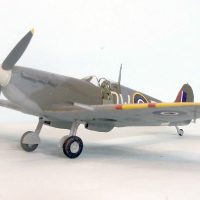
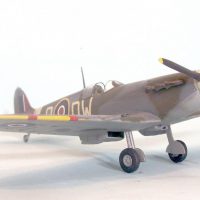

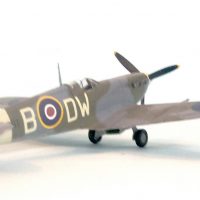
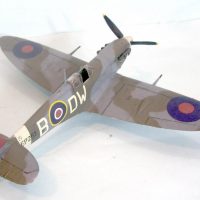
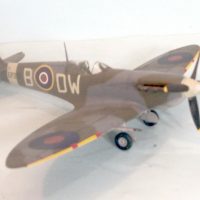
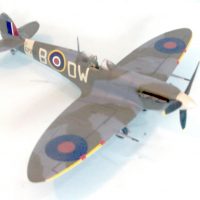
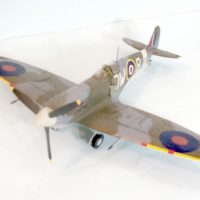
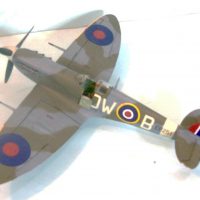
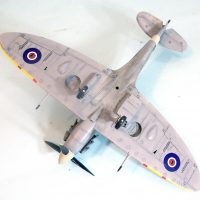

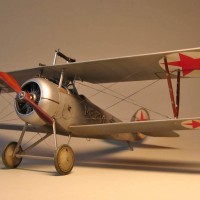
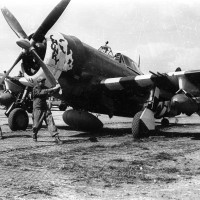
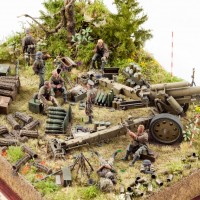
Hm. I've been using Testor's liquid cement on mine; so far nothing's fallen apart... Do the Tamiya Extra-Thin and Tenax have some weird chemistry? Not-quite-styrene cements?
It's a nice kit - you can't beat the extras with a stick. Three different kinds of exhausts, two propellers, three windscreens, clipped or regular wings, Vokes filter, slipper tank...and really just as nice a kit overall as the very nice Eduard MkIX.
Hi Susan, how come when I type your name in the members search box, it says "not found"...?
For info, article comments are open also to unregistered users.
I shall have to join!
By all means...you're most welcome.
Tenax and Tamiya are polystyrene-only adhesives. Testors, like Plastruct, is a more "generic" adhesive and will work on material other than polystyrene.
I knew the Spit was fast, but climb to 20,000 ft in 7.1 seconds? JK Thanks for the article
Edited. $%^%#$@! autocorrect.
Great article, this infos will be handy on the build.
Great article, and have wondered about exhaust thrust. Have you found any data on that? Years ago read that both the P-47 and -51 benefited from it, but no supporting numbers.
Try Testor's with the needle type applicator-MUCH neater and accurate than slathering Tenax all over the place.
On early mark Spitfires, the ejector exhausts (developed by Rolls-Royce for the Merlin) were found to add about 70 pounds of thrust, equivalent to about +70hp at 300 mph. IIRC this amounted to about +10 mph. The French Dewoitine D.520 adopted the same idea, for the same reason.
On Mk. V, the improvement of fishtail exhausts over the old ejector type was nowhere near as big, but they were claimed to be slightly more effective.
Exhaust thrust probably added 8-10 mph to most planes. Martin certainly knows more than I do here.
Nice work Tom. I'm scratching my head over the way they did the landing gear though. Was it difficult to get the angles correct?
Tom,
Good looking model and as always I enjoyed the article
Airfix' quality lapses in the plastic they use has GOT to be one of the great mysteries in plastic modeling today. Why they cannot find one optimum type and stick with it baffles me. Seems to me it would be a major improvement in overall quality and would go a long way in buttressing their reputation...which to be honest goes up and down like a rickety wooden rollercoaster.
That being said, its a great looking end result.